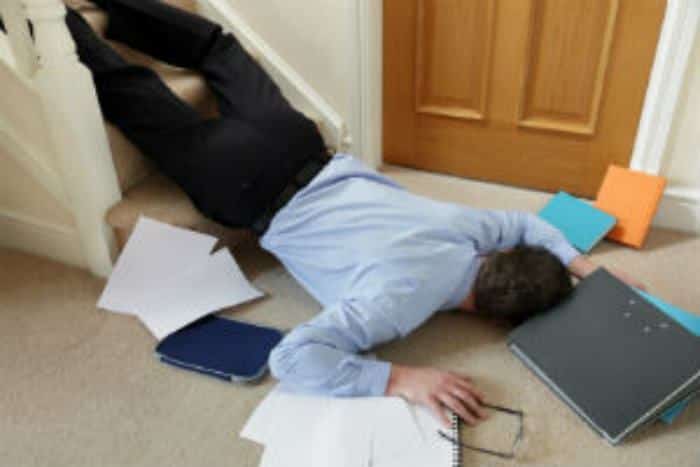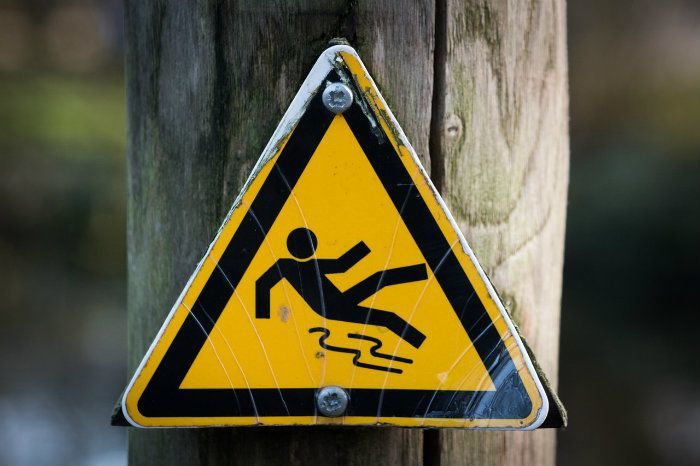Promoting Worker Knowledge About Slip, Trip, & Falls In The Workplace
While most employers and workers are familiar with the risks of driving for work-related purposes, chemical exposure and heavy machinery handling, few are familiar with the risks of slips, trips and falls in the workplace.
Fatalities and injuries associated with slip, trip and falls have been steadily increasing over the last few decades in the United States. In fact, slip, trip and falls constitute 15 percent of all accidental deaths and come in a close second to driving as a reason for workplace fatalities, according to the Occupational Safety & Health Administration (OSHA) from the Department of Labor. According to data from The National Institute for Occupational Safety and Health (NIOSH), 411 workers in manufacturing died because of occupational injuries. Falls were the third-most common reason for these workplace-related deaths. These consequences have put a huge burden on the American healthcare system and employers.
Potential Workplace Hazards Leading To Falls

Workers have the right to a safe working environment with the law requiring employers to equip employees with healthy and safe workplaces. The OSHA law allows employees to raise health and safety concerns in the workplace while prohibiting employers from reacting harshly against workers. Slip, trip and falls occur in a myriad of different situations some of which include:
- Ice
- Grease
- Wet spots
- Carpeting
- Loose flooring
- Polished or glazed floors
- Uneven surfaces
- Open desk drawers
- Electrical cords and wires
- Filing cabinets left open
- Clutter
- Damaged steps
Controlling these hazards is relatively simple, but is often ignored – causing these types of accidents to be more common than others. For instance, simple fixes like smoothing out floor surfaces, coiling extension cables, clearing clutter from floors, wearing icy weather lug soles and closing desk drawers will go a long way in protecting workers from these preventable hazards. OSHA has presented certain standards for working and walking surfaces. These standards apply to all employment places – except in the cases of agriculture or mining work. While OSHA covers aspects related to walking surfaces, it does not focus on worker training solutions that can potentially raise issues related to:
- Choosing proper footwear and clothes.
- Walking on dangerous surfaces.
- Following safety procedures to avoid dangerous falls.
- Improved knowledge of hazardous situations.
Keeping this in mind, North Carolina State University researchers from the Edward P. Fitts Department of Industrial and Systems Engineering most recently circulated the results of an experiment they conducted. The experiment assessed how internal factors like prior knowledge of the environment and worker training can change a circumstance when multitasking. The experiment results proposed that training programs led to the enhanced knowledge of the walking conditions, which led to greater ability to adjust walking strides to prevent slip, trip and falls in the workplace.
Controlling The Problem Of Hazards

Once hazards have been identified in the workplace, an employer must do everything or undertake every possible provision to protect workers. This compels employers to offer information and supervision for the benefit of workers at all times. Employers must plan the following when establishing best practices in workplaces.
- Physical work area characteristics.
- Risky weather conditions such as ice, snow or rain.
- Tasks that need to be performed.
- Work practices of the worker.
Controlling the problems of hazards in the workplace is a key responsibility of employers to protect employees and to avoid any expensive, long-drawn litigation processes. Some controls include:
Managing Floor Slipperiness
- Install slip resistant floors and mats, especially in vulnerable areas.
- Add handrails and ramps to areas with a slight slope for better grip.
- Obstruction-free surface for enhanced freedom of movement.
- Proper drainage to protect floors from prolonged wetness and mildew formation.
- Suitable lighting with minimal contrast and glare.
- Blocking wind and preventing wet surfaces from turning into ice.
- Install guardrails for balconies, mezzanines and raised floors.
- Proper grip for work platforms and ladders.
- Multitasking jobs should be planned to minimize cognitive tasks while employees move around in areas with potential slip, trip and fall hazards.
- Workplace floors should ideally be designed in a manner to minimize potential falling hazards.
- Rugs and mats should be securely fixed to floors.
Offering Administrative Protection
- Wet floor signboards for particular areas susceptible to wetness.
- Train workers and employees to prevent slipping, tripping and falling.
- Communicate a practice for reporting hazards.
- Establish prompt maintenance schedules to keep floors clean and slip-free.
- Correct poorly developed work practices.
- Use cable guards to protect from wire trips.
- Improve lighting and visibility in sloped or uneven areas.
Following Safer Work Practices
- Remove snow, ice and debris regularly to prevent accidents.
- Habitually clean floors with suitable cleaning solutions.
- Use both hands for climbing and coming down from ladders.
- Clean wheel cart casters to ensure that no slipping takes place.
- Removing clutter from surfaces used for walking.
- Work in appropriate footwear to prevent possible slipping.
- Maintain and use fall protection equipment.
- Clean spills immediately to prevent the growth of mold and mildew.
Employers are duty bound to ensure that all workers are protected from slip, trip, and falls. Reducing risks is typically easy and is inexpensive to ensure, but companies must pay close attention to this factor, which is often ignored or overlooked.
Identifying The Most At-Risk Workers

Some workers are at greater risk of injuries related to slip, trip and falls simply because of the nature of their work. These workers include:
- Construction workers – Falling is one of the biggest causes of workplace fatalities in the construction industry. Construction workers typically tend to use ladders and scaffolding. Sometimes safety gear can fail when workers are at heights, which can cause a worker to fall and get fatally injured.
- Home contractors – Roofers and builders are at most risk of a fall, which is similar to construction workers because they tend to work at heights above ground.
- Maintenance workers – People in maintenance are at risk of falling, slipping and tripping because they are constantly walking on wet and unsafe areas.
- Restaurant workers – Sticky or slippery surfaces can contribute to falling among restaurant workers. This can include cooks, servers, bartenders and bar backs because these workers move around in spaces covered by some type of liquid, which can contribute to a fall.
Promoting Worker Safety
A report published in Industrial Health indicates that slip, trip, and falls occur as a result of three different factors:
- Personal – Age, race, gender, body size, chronic illness, work experience, body strength, cognitive capability, substance use, visual perception, sensitivity to contrast, vision and more.
- Environmental – Physical and visual environmental interaction, elevation perception, visual scenes, visual ambiguity, depth perception, visual obstacle detection, support surface inclination, lighting, floor material, building design and much more.
- Task-related – Physical exertion, fatigue footwear, load handling, social interaction, task complexity, community resources and more.
A disability that occurs because of slip, trip and falls will significantly diminish the ability of a person to undertake his/her occupation and capacity to experience the same quality of life. The NIOSH is a federal organization that has conducted research to prevent work injuries related to slipping, tripping and falling in the United States for several decades. Employers throughout the country have utilized many research outcomes from NIOSH research, but solving the problem wholly remains vital. Undertaking a slew of high-impact preventive measures is perhaps the key to reducing the effect of slip, trip and falls on both employers and employees.
To effectively reduce injuries and deaths caused by slip, trip, and falls, a focused effort should include active partnerships, high-quality research, and practical actions. Employers should consider these factors to reduce the risk of injuries related to slip, trip, and falls:
- Risk identification – This establishes causes and risks associated with accidents in the workplace.
- Incident surveillance – Incident surveillance identifies the severity and magnitude of slip, trip and fall problems.
- Accident intervention – Accident intervention refers to design and evaluation of risks in different scenarios.
- Preventive implementation – Preventive implementation requires the establishment of preventive and safety measures in the workplace to avoid accidents.
If you end up falling at work, a serious or long-lasting injury may not be instantly obvious. Sprains and strains in muscles may not hurt you right away, but that doesn’t mean that your body is not damaged. An injured ankle, wrist or knee may keep you from performing your duties at work for extended periods, while a serious injury may prevent you from working at all. Understanding your rights as an employee will help you know the correct action to take when such a fall happens in the workplace.
